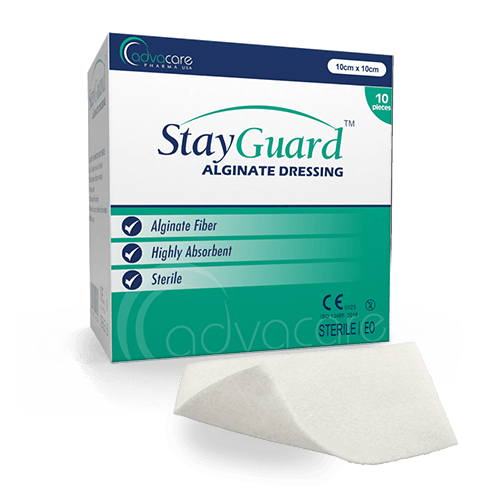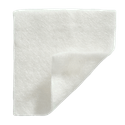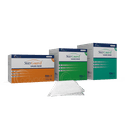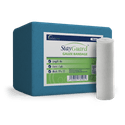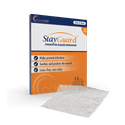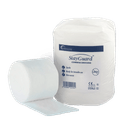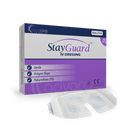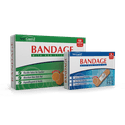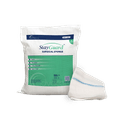- Home›
- Medical Devices›
- Skin & Wound Care›
- Wound Dressings›
- Alginate Dressing
Alginate Dressing
Material
Size
Packaging
What is an Alginate Dressing?
An Alginate Dressing is a versatile wound dressing made from fibers derived from seaweed. When this dressing comes into contact with wound exudate, it forms a gel-like substance that promotes a moist healing environment. Alginate dressings are available in various sizes to accommodate different wound sizes and shapes.
The gel formed by the alginate fibers creates a protective barrier that helps to prevent infection and supports the natural healing process. These dressings are particularly effective for managing highly exuding wounds, such as venous ulcers, pressure ulcers, and surgical wounds. Alginate dressings are also known for their ability to conform to irregular wound surfaces.
At AdvaCare Pharma, we are passionate about providing our customers with the best possible Alginate Dressings. That's why we only use the highest quality materials and manufacturing processes. Our products are rigorously tested to ensure that they meet the highest safety standards. We are proud to offer a wide variety of alginate dressings to choose from, and we are confident that you will find the perfect one for your needs.
Product Specifications
Features
Medical-grade Alginate Fiber is an advanced wound dressing known for its exceptional absorption capacity, effectively minimizing the risk of infection and promoting accelerated healing. Its highly absorbent nature enables it to soak up to 20 times its weight in wound exudate, maintaining a moist environment optimal for healing.
This type of dressing also encourages natural enzymatic debridement, facilitating the removal of necrotic tissue. Additionally, it possesses the advantage of not adhering to delicate tissue within the wound bed, ensuring gentle and pain-free removal. Due to its remarkable properties, alginate dressing is widely recognized as one of the most commonly used advanced wound dressings.
Why are we a leading Alginate Dressing manufacturer?
AdvaCare Pharma has built a strong reputation as a reliable exporter and manufacturer of Alginate Dressings, and other wound dressings, for more than 20 years. Our wide-ranging network of partnerships with distributors, hospitals, NGOs, and pharmacies in 65 markets showcases our commitment to providing quality products and services.
At AdvaCare Pharma, our main focus is on manufacturing alginate dressings, and other specialty wound dressings, that are quality-assured and affordable. Through our StayGuard™ line of skin and wound care products, including Alginate Dressings, we strive to meet the ever-growing and ever-changing needs of healthcare professionals worldwide.
Uses
How should Alginate Dressing be used?
To properly utilize alginate dressing:
- Begin by meticulously cleansing the wound and preparing the wound bed to optimize healing conditions.
- After guaranteeing a sterile environment, carefully unpack the alginate dressing and gently apply it over the wound, checking for full coverage and slight overlap beyond the wound edges. If the wound is heavily exuding, consider lightly moistening the dressing with sterile saline to activate its absorbent properties.
- Secure the dressing in place with an appropriate secondary dressing to keep its position and protect the wound site.
- Regular monitoring of the dressing and the wound's progress is required, along with adhering to healthcare provider instructions regarding dressing changes and wound care protocols to mitigate the risk of complications.
What precautions should be considered when using Alginate Dressing?
When utilizing alginate dressing, monitor the dressing regularly to evaluate the degree of exudate absorption and the overall progress of wound healing. Given that alginate dressings are intended to absorb moisture and foster a moist wound environment conducive to healing, adherence to the suggested frequency of dressing changes outlined in the product instructions and tailored to the wound's condition is paramount.
Routine assessment of the wound for any indications of infection, excessive exudate, or potential complications is paramount. Consulting with a healthcare professional for guidance and adjustments to the treatment plan as needed aids in wound management and encourages favorable outcomes.
Can Alginate Dressings be used on all types of wounds?
Alginate dressings are particularly suitable for moderately to heavily exuding wounds, including venous ulcers, pressure ulcers, diabetic foot ulcers, and surgical wounds.
The high absorbency of alginate fibers enables them to manage exudate very well, making them ideal for wounds with moderate to high levels of wound fluid. However, alginate dressings may not be suitable for wounds with minimal exudate or dry wounds, as they need moisture to function correctly.
Wounds with exposed structures such as bones or tendons may require an additional layer of protection, such as a secondary dressing, to prevent direct contact with the alginate dressing.
How should Alginate Dressings be applied to wounds?
To apply alginate dressings to wounds:
- Begin by preparing the wound bed according to standard wound care protocols, guaranteeing that it is clean and free from debris.
- Select an appropriately sized alginate dressing based on the dimensions and exudate level of the wound.
- Place the alginate dressing directly onto the wound surface, checking that it covers the entire wound bed and extends slightly beyond the wound margins.
- If needed, lightly moisten the dressing with sterile saline solution to activate its absorptive properties.
- Secure the alginate dressing in place using an appropriate secondary dressing, such as a non-adherent pad or adhesive tape.
- Confirm that the dressing is properly secured and that the wound is adequately protected.
What are the advantages of using Alginate Dressings over traditional wound dressings?
Alginate dressings present several advantages over traditional wound dressings, making them a preferred choice in many clinical settings:
- Alginate dressings have superior absorbent properties, capable of absorbing up to 20 times their weight in wound exudate. This high absorbency helps to preserve a moist wound environment, which is foundational for fostering maximum wound healing.
- Alginate dressings conform easily to the contours of the wound bed, making for a snug fit and maximum contact with the wound surface.
- The gel formed by alginate fibers upon contact with wound exudate gives a protective barrier against microbial contamination, reducing the risk of infection.
The properties of alginate dressings contribute to faster wound healing, elevated patient comfort, and better clinical outcomes.
What factors should be considered when selecting Alginate Dressings for wound management?
When selecting alginate dressings for wound management, several factors should be taken into consideration to obtain ideal outcomes:
- Assess the wound characteristics, including size, depth, and exudate level, to determine the appropriate dressing type and size.
- Alginate dressings are suitable for moderately to heavily exuding wounds, so make sure that the wound produces enough exudate to benefit from the absorbent properties of alginate fibers.
- Consider the patient's medical history, allergies, and skin sensitivity when choosing dressing materials to minimize the risk of adverse reactions.
- Evaluate the wound location and surrounding tissue condition to select a dressing that conforms well to irregular wound shapes and contours.
- Consult with a healthcare professional or wound care specialist to determine the most suitable alginate dressing and develop a comprehensive wound management plan tailored to the individual patient's needs.
FAQs
How do Alginate Dressings work?
Alginate dressings work by absorbing wound exudate and forming a gel-like substance, which helps to maintain a moist environment that is conducive to wound healing. This gel also assists in the removal of dead tissue and promotes the formation of new, healthy tissue.
Are Alginate Dressings suitable for all types of wounds?
Alginate dressings are commonly used for moderate to heavily exuding wounds, such as pressure ulcers, venous leg ulcers, and diabetic foot ulcers. They may not be appropriate for wounds with minimal exudate or dry wounds, as they require moisture to function effectively.
How often should Alginate Dressings be changed?
The frequency of dressing changes depends on the amount of wound exudate and the specific instructions provided by the healthcare professional. Typically, alginate dressings are changed every one to three days, or as recommended by the healthcare provider, to ensure optimal wound healing and prevent excessive dressing saturation. Regular monitoring of the wound is important to determine the appropriate interval for dressing changes.
Are your Alginate Dressings CE marked?
Our alginate dressings are certified with the CE mark, signifying compliance with European Union regulations. Moreover, our manufacturing procedures adhere rigorously to ISO standards for consistent quality and safety assurance.
Is there flexibility in packaging options for your Alginate Dressings?
We do provide various packaging options for many medical device products to adapt to the preferences of local healthcare providers. However, packaging materials can affect production costs. Therefore, it is important to balance market preferences and price points to ensure the economic viability of medical devices in each respective market.
References
Alginate in Wound Dressings
This study discusses the use of alginate in wound dressings, highlighting its biocompatibility, non-toxicity, and ability to absorb excess wound fluid, maintain a physiologically moist environment, and minimize bacterial infections at the wound site. Alginate is derived from brown seaweed and is composed of a varied ratio of guluronate and mannuronate, which depends on the source. It is also non-immunogenic and has been used in various forms of materials for wound dressings, such as hydrogels, films, wafers, foams, nanofibers, and topical formulations.
The study also mentions that alginate dressings can be tailored to materials with properties suitable for wound healing and can be combined with synthetic polymers to enhance their mechanical properties.
Chronic Wounds and Their Therapy with Alginate-Based Dressings
This study provides an overview of the use of alginate-based wound dressings in the treatment of chronic wounds, focusing on the review by Andreea Barbu et al. entitled "Current Trends in Advanced Alginate-Based Wound Dressings for Chronic Wounds." The review highlights the versatility and advantages of alginate-based wound dressings, which are derived from brown algae and composed of long chains of guluronic and mannuronic acid. These dressings are able to absorb large amounts of exudate and maintain a moist wound environment, important for healing. Alginate-based dressings can be left in place for up to 7 days, are non-adherent, do not cause skin irritation, are available in a variety of sizes, and are relatively inexpensive.
The study also mentions that alginate-based dressings promote the formation of new granulation tissue, provide a scaffold for cell migration, stimulate fibroblast proliferation, and collagen synthesis, thereby promoting wound healing.

You might be interested in...
Why AdvaCare Pharma?
As an industry leader, we are aware of our responsibility to provide affordable and sustainable solutions to improve healthcare worldwide.
